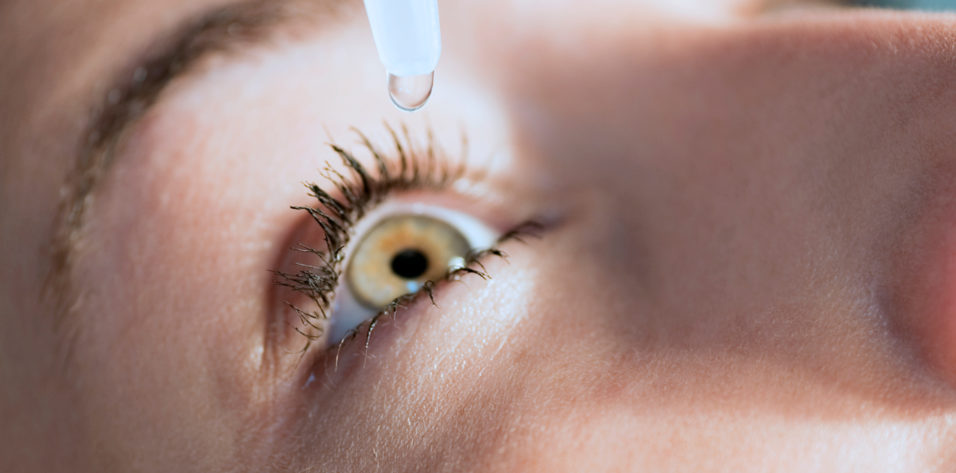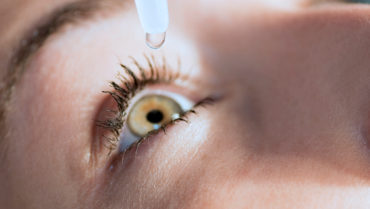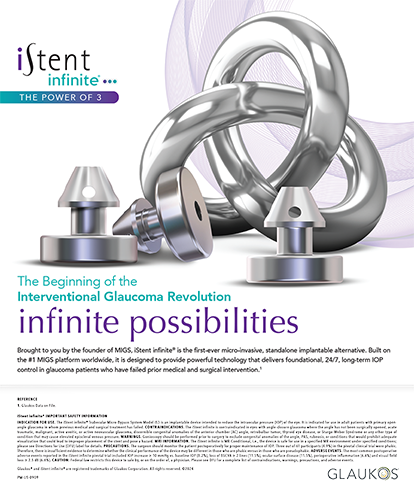
Practical Guidance for the Use of Cyclosporine Ophthalmic Solutions in the Management of Dry Eye Disease
de Oliveira RC, Wilson SE1
Industry support: No
ABSTRACT SUMMARY
In this review article, de Oliveira and Wilson describe the mechanism of action for cyclosporine A (CsA) in dry eye disease (DED) as well as the drug’s pharmacologic properties. As an inhibitor of calcineurin, CsA prevents T-cell production of the inflammatory cytokines and disrupts the immune-mediated inflammatory response.2,3 These actions help to decrease DED-induced inflammation associated with the corneal and conjunctival epithelium, accessory lacrimal glands, and subconjunctival tissues. It also increases conjunctival goblet cell density and tear production.
STUDY IN BRIEF
• The antiinflammatory agent cyclosporine A (CsA) often improves treatment outcomes in patients with dry eye disease (DED), but eye care providers must consider disease severity, therapeutic efficacy, side effects, and dosing. This review article addresses how CsA works and its pharmacologic properties, the management of DED, the role of patient education, and the length of treatment.
WHY IT MATTERS
Eye care providers must have effective treatments at the ready for the growing number of patients affected by DED. It is important for clinicians to have a firm understanding of how each therapeutic option works and its role in practice. This article provides important evidence-based information on the use of CsA for DED.
In their article, de Oliveira and Wilson provide a chart listing details on the seven CsA formulations available worldwide. They also look at studies comparing the two FDA-approved ophthalmic CsA treatments: Restasis (cyclosporine ophthalmic emulsion 0.05%, Allergan) and Cequa (cyclosporine ophthalmic emulsion 0.09%, Sun Pharmaceutical). In one study, Restasis treatment led to a statistically significant improvement in tear production of more than 10 mm of wetting in 5 minutes via Schirmer testing in 15% of patients compared with 5% of the vehicle-treated control patients.4 Both Restasis and Cequa have been shown to be safe and effective, but some preliminary studies have suggested that Cequa may be better tolerated. Restasis was associated with ocular burning in 16% of patients in two multicenter studies.5 It also takes longer to be effective. De Oliveira and Wilson note that trials comparing Restasis and Cequa head-to-head would be useful for eye care providers.
DISCUSSION
DED is a multifactorial disease that involves the ocular surface and tear film. It can be caused by increased tear film evaporation (evaporative DED) and/or decreased tear production (aqueous-deficient DED). Underlying the pathophysiology of DED is a self-perpetuating inflammatory cycle.6-8
DED is becoming increasingly common among eye care patients, particularly adults older than 40 years and women. The disease is associated with nearly $4 billion in annual costs in the United States.9
Control of ocular surface inflammation can improve DED treatment outcomes. Although topical steroids may be a therapeutic option, their long-term use has been associated with side effects. Many studies have shown CsA treatment to be a safe and effective strategy for managing DED.
In their article, de Oliveira and Wilson provide several practical tips for managing patients with DED who may require CsA. The researchers note that, although the FDA approved Restasis for the management of moderate to severe keratoconjunctivitis sicca, the drug can also be effective for the treatment of mild DED and may prevent DED from worsening.
Deciding on the frequency and duration of CsA instillation and managing side effects can be challenging. Recommended dosing is one drop instilled twice a day in each eye, but some providers and researchers have found that instilling CsA four times a day produces a more rapid clinical response. This more frequent dosing may be effective in patients with severe DED, and it appears to be associated with an insignificant level of systemic absorption.10 With any CsA dosing regimen, however, side effects are possible, including burning, stinging, and conjunctival hyperemia. For this reason, de Oliveira and Wilson recommend educating patients on potential side effects and encouraging them to continue treatment despite side effects because these effects typically dissipate as the health of the ocular surface improves.
Some DED patients may require CsA treatment indefinitely. Although some studies have focused on treatment for short periods (eg, 12 months), these same studies have found that symptoms may return and/or DED may progress after medication withdrawal. With this in mind, de Oliveira and Wilson note that research is needed to address the long-term efficacy of CsA treatment.
Influence of Bacterial Burden on Meibomian Gland Dysfunction and Ocular Surface Disease
Nattis A, Perry HD, Rosenberg ED, Donnenfeld ED11
Industry support: No
ABSTRACT SUMMARY
This prospective, observational study by Nattis and colleagues included both eyes of 40 patients (10 men and 30 women) treated at a single practice. The mean patient age was 55.25 years. Patients were divided into four groups, with 10 patients in each group. All of them were evaluated for signs and symptoms of DED and meibomian gland dysfunction (MGD).
STUDY IN BRIEF
• For this prospective, observational, single-center study, researchers assessed the bacterial burden on the eyelid margins and within the meibomian glands in 40 patients. The investigators divided patients into four groups based on severity of meibomian gland dysfunction (MGD) or ocular surface disease (OSD). After obtaining cultures and performing a variety of diagnostic tests, the researchers found a predominance of coagulase-negative staphylococci within the biofilms of both healthy patients and those with clinically significant MGD or OSD.
WHY IT MATTERS
Resolving MGD and OSD can be challenging. Based on the results of this study, clinicians should consider addressing the bacterial biofilm when other forms of treatment prove ineffective or insufficient.
The examination findings for patients in group A—the control group—were routine, without evidence of DED or MGD. Their Ocular Surface Disease Index (OSDI) scores were 0 to 40. Group B patients had no symptoms and few to no complaints about ocular discomfort, but components of their examinations suggested mild DED and/or MGD. Their OSDI scores were 50 or below. Group C patients had subclinical disease, occasionally voiced complaints consistent with ocular surface disease (OSD), and showed evidence of mild to moderate DED and/or MGD on examination. Their OSDI scores were 63 or below. Group D patients had clinically significant MGD and/or OSD, including symptoms of nearly constant burning, irritation, or dryness and evidence of significant disease. The OSDI scores in this group were 100 or below.
All of the patients received a slit-lamp examination and underwent culturing and sensitivity testing of the eyelid margin and meibomian gland secretions, tear osmolarity, matrix mellaproteinase 9, Schirmer I testing without anesthesia, and meibography. Lissamine green staining was also performed.
The primary outcome measures were degree of bacterial burden and culture results as correlated with DED and MGD diagnostic parameters.
The mean OSDI score was 36.16 among all groups, with mean score severity increasing from group A (19.73) to group D (54.46). The mean tear osmolarity test score was not statistically significantly different across groups or eyes. Although 37.5% of right eyes and 47.5% of left eyes were matrix mellaproteinase 9–positive, these results were not statistically different across groups or eyes. No statistically significant relationship was found between Schirmer I scores and eyelid margin or meibomian gland cultures.
Among all groups, 62.5% of right eyes and 75% of left eyes had positive cultures. Among positive cultures, 48% of right eyes and 63% of left eyes had positive lid margin cultures. Meibomian gland cultures were positive in 52% of right eyes and 36% of left eyes. Moreover, among the positive cultures, 84% of right eyes and 76% of left eyes were positive for coagulase-negative staphylococci (CoNS). One right-eye culture was resistant to erythromycin (CoNS), and 10 left-eye cultures were resistant to erythromycin (CoNS, Staphylococcus aureus). Most positive cultures were susceptible to tetracycline, and two left-eye cultures were resistant to tetracycline (both CoNS). Detailed analysis of each patient group found a greater range of organisms. In addition to CoNS and S aureus, other organisms detected included Corynebacterium, Bacillus, Actinomyces, and Haemophilus influenzae.
DISCUSSION
Tear film instability, reduced tear breakup time, and evaporative DED are among the visual effects of MGD. Left untreated, MGD can cause or worsen DED symptoms, including dryness, burning, itching, tearing, and foreign body sensation. It can be challenging to treat MGD, blepharitis, and DED, and therapy often must be individualized. Although various species of bacteria on the eyelids may cause or exacerbate MGD, no studies to date have evaluated the correlation of bacterial burden with specific markers of DED or OSD. Nor has there been a comparison of eyelid or meibomian gland bacterial burden across the disease spectrum.
Nattis and colleagues found a variety of positive cultures and different organisms within and among the study groups. Other researchers have addressed the influence of bacterial biofilm, bacterial lipases, and bacterial colonization on the eyelids and within meibomian gland secretions. This study reinforces those earlier findings. Nattis and colleagues did not identify a significant or definitive correlation between positive eyelid margin and meibomian gland cultures and the degree of disease, but that may be due to the study’s small sample size.
The idea that positive cultures are present across the MGD spectrum fits a theory that DED and blepharitis are a disease spectrum influenced by the biofilm that forms on the lid margin over time.12,13 Biofilm formation might have allowed colonization with the organisms found in this study.
The study authors state that, based on this study’s findings, patients whose DED, blepharitis, and/or MGD does not improve with typical therapy may benefit from mechanical debridement of the eyelids.
1. de Oliveira RC , Wilson SE. Practical guidance for the use of cyclosporine ophthalmic solutions in the management of dry eye disease. Clin Ophthalmol. 2019;13:1115-1122.
2. Kunert KS, Tisdale AS, Stern ME, Smith JA, Gipson IK. Analysis of topical cyclosporine treatment of patients with dry eye syndrome: effect on conjunctival lymphocytes. Arch Ophthalmol. 2000;118(11):1489-1496.
3. Stern ME, Beuerman RW, Fox RI, Gao J, Mircheff AK, Pflugfelder SC. The pathology of dry eye: the interaction between the ocular surface and lacrimal glands. Cornea. 1998;17(6):584-589.
4. Restasis (cyclosporine ophthalmic emulsion) 0.05% [package insert]. Irvine, CA: Allergan, Inc. 2017; https://www.allergan.com/assets/pdf/restasis_pi.pdf.
5. Sall K, Stevenson OD, Mundorf TK, Reis BL. Two multicenter, randomized studies of the efficacy and safety of cyclosporine ophthalmic emulsion in moderate to severe dry eye disease. CsA Phase 3 Study Group. Ophthalmology. 2000;107(4):631-639.
6. Pflugfelder SC, de Paiva CS. The pathophysiology of dry eye disease: what we know and future directions for research. Ophthalmology. 2017:124(11 suppl):S4-S13.
7. Wilson SE. Inflammation: a unifying theory for the origin of dry eye syndrome. Manag Care. 2003;12(12 suppl):14-19.
8. Ganesalingam K, Ismail S, Sherwin T, Craig JP. Molecular evidence for the role of inflammation in dry eye disease. Clin Exp Optom. 2019;102(5):446-454.
9. McDonald M, Patel DA, Keith MS, Snedecor SJ. Economic and humanistic burden of dry eye disease in Europe, North America, and Asia: a systematic literature review. Ocul Surf. 2016;14(2):144-167.
10. Stevenson D, Tauber J, Reis BL. Efficacy and safety of cyclosporin A ophthalmic emulsion in the treatment of moderate-to-severe dry eye disease: A dose-ranging, randomized trial. The Cyclosporin A Phase 2 Study Group. Ophthalmology. 2000;107(5):967-974.
11. Nattis A, Perry HD, Rosenberg ED, Donnenfeld ED. Influence of bacterial burden on meibomian gland dysfunction and ocular surface disease. Clin Ophthalmol. 2019;13:1225-1234.
12. Dougherty JM, McCulley JP. Bacterial lipases and chronic blepharitis. Invest Ophthalmol Vis Sci. 1986;27(4):486-491.
13. Rynerson J, Perry HD. DEBS—a unification theory for dry eye and blepharitis. Clin Ophthalmol. 2016;10:2455-2467.




